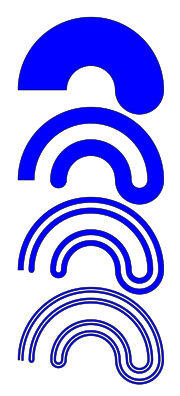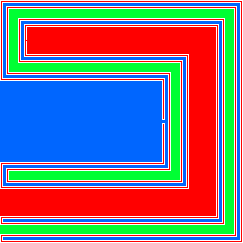
In point-set topology, an indecomposable continuum is a continuum that is indecomposable, i.e. that cannot be expressed as the union of any two of its proper subcontinua. In 1910, L. E. J. Brouwer was the first to describe an indecomposable continuum.
Indecomposable continua have been used by topologists as a source of counterexamples. They also occur in dynamical systems.
Definitions
A continuum is a nonempty compact connected metric space. The arc, the n-sphere, and the Hilbert cube are examples of path-connected continua; the topologist's sine curve is an example of a continuum that is not path-connected. The Warsaw circle is a path-connected continuum that is not locally path-connected. A subcontinuum of a continuum is a closed, connected subset of . A space is nondegenerate if it is not equal to a single point. A continuum is decomposable if there exist two subcontinua and of such that and but . It follows that and are nondegenerate. A continuum that is not decomposable is an indecomposable continuum. A continuum in which every subcontinuum is indecomposable is said to be hereditarily indecomposable. A composant of an indecomposable continuum is a maximal set in which any two points lie within some proper subcontinuum of . A continuum is irreducible between and if and no proper subcontinuum contains both points. For a nondegenerate indecomposable metric continuum , there exists an uncountable subset such that is irreducible between any two points of .
History

In 1910 L. E. J. Brouwer described an indecomposable continuum that disproved a conjecture made by Arthur Moritz Schoenflies that, if and are open, connected, disjoint sets in such that , then must be the union of two closed, connected proper subsets. Zygmunt Janiszewski described more such indecomposable continua, including a version of the bucket handle. Janiszewski, however, focused on the irreducibility of these continua. In 1917 Kunizo Yoneyama described the Lakes of Wada (named after Takeo Wada) whose common boundary is indecomposable. In the 1920s indecomposable continua began to be studied by the Warsaw School of Mathematics in Fundamenta Mathematicae for their own sake, rather than as pathological counterexamples. Stefan Mazurkiewicz was the first to give the definition of indecomposability. In 1922 Bronisław Knaster described the pseudo-arc, the first example found of a hereditarily indecomposable continuum.
Bucket handle example
Indecomposable continua are often constructed as the limit of a sequence of nested intersections, or (more generally) as the inverse limit of a sequence of continua. The buckethandle, or Brouwer–Janiszewski–Knaster continuum, is often considered the simplest example of an indecomposable continuum, and can be so constructed (see upper right). Alternatively, take the Cantor ternary set projected onto the interval of the -axis in the plane. Let be the family of semicircles above the -axis with center and with endpoints on (which is symmetric about this point). Let be the family of semicircles below the -axis with center the midpoint of the interval and with endpoints in . Let be the family of semicircles below the -axis with center the midpoint of the interval and with endpoints in . Then the union of all such is the bucket handle.
The bucket handle admits no Borel transversal, that is there is no Borel set containing exactly one point from each composant.
Properties
In a sense, 'most' continua are indecomposable. Let be an -cell with metric , the set of all nonempty closed subsets of , and the hyperspace of all connected members of equipped with the Hausdorff metric defined by . Then the set of nondegenerate indecomposable subcontinua of is dense in .
In dynamical systems
In 1932 George Birkhoff described his "remarkable closed curve", a homeomorphism of the annulus that contained an invariant continuum. Marie Charpentier showed that this continuum was indecomposable, the first link from indecomposable continua to dynamical systems. The invariant set of a certain Smale horseshoe map is the bucket handle. Marcy Barge and others have extensively studied indecomposable continua in dynamical systems.
See also
- Indecomposability (constructive mathematics)
- Lakes of Wada, three open subsets of the plane whose boundary is an indecomposable continuum
- Solenoid
- Sierpinski carpet
References
- Nadler, Sam (2017). Continuum Theory: An Introduction. CRC Press. ISBN 9781351990530.
- Brouwer, L. E. J. (1910), "Zur Analysis Situs", Mathematische Annalen, 68 (3): 422–434, doi:10.1007/BF01475781, S2CID 120836681
- Cook, Howard; Ingram, William T.; Kuperberg, Krystyna; Lelek, Andrew; Minc, Piotr (1995). Continua: With the Houston Problem Book. CRC Press. p. 103. ISBN 9780824796501.
- Ingram, W. T.; Mahavier, William S. (2011). Inverse Limits: From Continua to Chaos. Springer Science & Business Media. p. 16. ISBN 9781461417972.
- Kennedy, Judy (1 December 1993). "How Indecomposable Continua Arise in Dynamical Systems". Annals of the New York Academy of Sciences. 704 (1): 180–201. Bibcode:1993NYASA.704..180K. doi:10.1111/j.1749-6632.1993.tb52522.x. ISSN 1749-6632. S2CID 85143246.
External links
- Solecki, S. (2002). "Descriptive set theory in topology". In Hušek, M.; van Mill, J. (eds.). Recent progress in general topology II. Elsevier. pp. 506–508. ISBN 978-0-444-50980-2.
- Casselman, Bill (2014), "About the cover" (PDF), Notices of the AMS, 61: 610, 676 explains Brouwer's picture of his indecomposable continuum that appears on the front cover of the journal.
 is a nonempty
is a nonempty  of a continuum
of a continuum  and
and  of
of  and
and  but
but  . It follows that
. It follows that  and
and  if
if  and no proper subcontinuum contains both points. For a nondegenerate indecomposable metric continuum
and no proper subcontinuum contains both points. For a nondegenerate indecomposable metric continuum  , there exists an uncountable subset
, there exists an uncountable subset  such that
such that  and
and  are open, connected, disjoint sets in
are open, connected, disjoint sets in  such that
such that  , then
, then  projected onto the interval
projected onto the interval  of the
of the  -axis in the plane. Let
-axis in the plane. Let  be the family of semicircles above the
be the family of semicircles above the  and with endpoints on
and with endpoints on  be the family of semicircles below the
be the family of semicircles below the  and with endpoints in
and with endpoints in  . Let
. Let  be the family of semicircles below the
be the family of semicircles below the  and with endpoints in
and with endpoints in  . Then the union of all such
. Then the union of all such  be an
be an  -cell
-cell ,
,  the set of all nonempty closed subsets of
the set of all nonempty closed subsets of  the hyperspace of all connected members of
the hyperspace of all connected members of  defined by
defined by  . Then the set of nondegenerate indecomposable subcontinua of
. Then the set of nondegenerate indecomposable subcontinua of